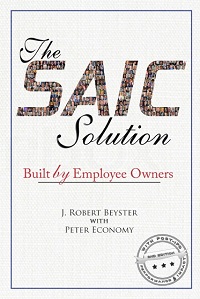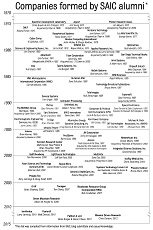Book Ideas, Employee Ownership, and Alternative Energy Solutions
10 Comments Published by Dr. Beyster January 18th, 2010 in Employee Ownership, Energy, Network Solutions.I would like to thank all of you who responded to my post a couple weeks ago asking for your opinion on which theme we should address in our next book. It seems to me that the votes were pretty evenly split between big-idea book and a book about the Network Solutions story. As I read your comments, I realized that a story about NSI could be written in a way that would provide companies and those who lead them with lessons that could help them revitalize the American industrial base. Employee ownership played a great role in the growth and success of SAIC and NSI, and it can play a role in strengthening American business. Please let me know if you have any further thoughts on the book theme.
Over the next few weeks I am going to write a paper on the apparent conflict between certain alternative energy solutions and their effect on the environment. For example, although large wind farms on the coast could generate huge amounts of electricity, some environmentalists are concerned about the impact of large wind farms on the environment. I don’t personally know if this conflict is real, but I plan to explore it. If you’ve got any strong feelings on the topic pro or con, please mention them on the blog so I can consider your points of view as I write the article.
– Bob





Wind should be a leading alternative energy contender, but have you forgotten your roots? Nuclear is an environmental winner. Not the 4 and 5 thousand megawatt behemoths of the past, but smaller cheaper safer systems that are faster to build and easier to manage. It’s a matter of design and desire. Lead the way.
If you decide to write about Network Solutions, you should include the way the IPO was handled. I’m thinking specifically of the opportunity you gave SAIC employees to acquire stock at the IPO. I availed myself of the opportunity you gave us (and made a $56,000 profit on an $1,800 investment!) Thanks Bob!
There is little new that can be added technically to the energy subject; however, putting the data in a format that describes each alternative and then compares the pros and cons of each together with solid economics and quantitative environmental issues might be a big benefit. A summary chapter of comparison with a recommended course of national action and a road map toward that action might be a bold addition. What we have been missing since before the Carter administration is an energy policy (they all promised one and that they would wean us off imported oil) and besides politics and ineptitude, there seems to be a lack of a solid decision process. Currently the white house is pushing a major reduction and elimination of some nuclear research. Nuclear is clearly a key component of any energy policy.
“It is morally obscene to regard wealth as an anonymous, tribal product and to talk about ‘redistributing’ it.”
From an SAIC friend:
“Carol Browner, EPA administrator under Clinton is the current Head of the White House Office of Energy and Climate Change Office of Climate Change!? What’s next? How about an “Office of Human Effect on the Force of Gravity?”
Bob,
Don’t forget there are alternative types machines to create wind energy.
Magenn Inc is about to release their Air Rotor – which will be a tethered rotor hundred of feet in the air – the first units will not be major energy generators (first release is the 100kw unit) yet the technology is there to create up to 1.5mw generation per unit.
This means no ground based blade technology use. And a very different visual for the land. Remember that if you go 400 or more feet up – there is constant wind – and you don’t need to place the units only where there is ground wind – which can be inconsistent anyway.
Cheers, Blake
Blake: I’m glad to hear about your interest in wind power. I’ve got a question for you: Which approach to wind power do you think is best? What conditions are best? Do you think there are enough suitable locations to make this a viable alternative source of energy in this country? — Bob
Michael: We’re not currently planning to address alternative energy strategies in the new book, but it is a topic that should be addressed. I will do so in a future post on this blog. — Bob
Donna: You’re welcome. You worked hard and deserved it. — Bob
Mark: I agree with you on smaller-sized nuclear reactors, but I don’t know of any that exist today that are generating significant amounts of power. Would you direct me to some information that you might have on this? — Bob
Bob,
Alternative Wind Machines:
Present wind energy is created using the rotor blade technology which has been driving this industry for many years (since wind first turned a windmill for water or grinding mill). Yet the nature of wind near earth is eratic. This reduces capacity.
High altitude wind – 400-1000 feet – has capacity in almost every location with a consistent reliable wind (www.windmapperpro.com) Capacity can be increased from under 20% to about 50%
Air Rotors, employing a 3-dimensional structure has low start speed, high torque, and high efficiency. These units use the have been developed and production is underway. Less expensive per unit of energy output than other wind generating systems.
Using the Air Rotor allows building wind farms closer to demand centers, reducing transmission costs and energy losses.
The 100kw units (first to market) are mobile and may be transfered to emergency situations or remote areas.
Here is a quote to consider:
“There is enough energy in high altitude winds to power civilization 100 times over; and sooner or later, we’re going to learn to tap into the power of winds and use it to run civilization.” Says Ken Caldeira, Professor of Global Ecology at the Carnegie Institution for Science. (Discovery Channel, Project Earth, Infinite Winds episode)
For more info – and a company that is leading the way in this development see: http://www.magenn.com/about.php
Cheers,
Blake
Blake: Thank you for the additional information on tapping into high-altitude winds as a new source of energy. How is the power transported from the generators to the ground? A long cable? — Bob